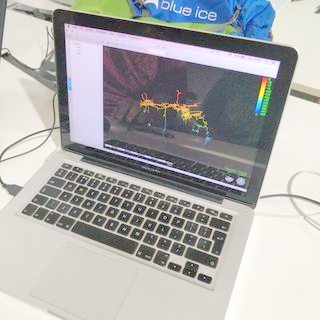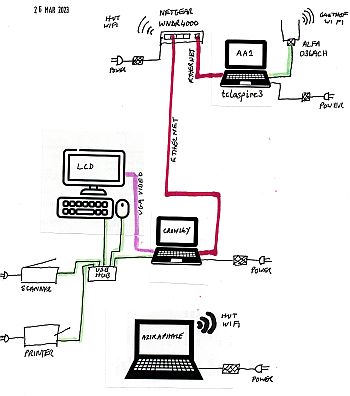
If the internet is not working, the first thing to check is that
the black WiFi antennae are
still upright and have not been knocked sideways.
Since 2018 we now have proper internet access in the tatty hut so the set-up on expo is exactly the same as the rest of the year. One or two Expo laptops are provided, but you should be able to use your own computer in exactly the same way (if you brought one) as you do at home.

We have our own WiFi ("tattyhut" and usual cavey:beery password) which is connected (deviously) to the Gasthof campsite WiFi. So please don't stream video or do a lot of operating system updates using it as the Gasthof is probably paying per GB to their supplier.
Our own Wifi only works very close to the tatty hut. If you are camped over the road near the Gasthof you will need to use the Gasthof WiFi 'staudnwirt'. This takes you to a login page on a web browser and it will log you out if you stop using it or whenever it thinks you have been on too long. Get instructions from the Gasthof campsite reception.
Expo now requires so much nerding that it is part of the pre-expo training.
The primary Expo laptop in the tatty hut is a 2011 Dell Latitude E4200 laptop 'Crowley' (on loan from Philip Sargent) which is connected to the hut network by a cable. It also has an external numberpad available as a couple of vital keys are dead (e.g. down-arrow, del - it has a new keyboard in 2023 but the contacts on the ribbon cable need cleaning).
This Expo laptop runs Linux [Cinnamon/Debian] and is configured as both
an Expo survey laptop with Tunnel and Therion and as an
Expo bulk update laptop.

this is much smarter then the expo laptops
It is mostly used for:
Any laptop or phone can connect to the server via the "tattyhut" WiFi and, with some configuration, can be set up to do all those things too. New expoers are advised to use an Expo laptop first to see how it all works.
The laptop is usually positioned permanently on the unused stove and is connected by ethernet cable to the hut network. It is connected to an extra LCD screen and external full-size keyboard (where all the keys do work) and mouse. The bigger screen is so that you can see surveys more easily as the laptop itself is small.
Through the miracle of the distributed version control system, everyone can edit the data on multiple laptops at the same time and it should all get merged.
At the end of expo we don't need to bring the Expo laptop back back to the UK (though we will, as we will want to do operating system updates during the year) as all the caving data updates are continuously synchronised with the public server expo.survex.com during the expo.
For experienced expo surveyers the Expo laptop is also set up as an Expo bulk update laptop with file-transfer and version control capability to the expo server. New expoers should use the web forms, which work from any browser on any laptop.
Once you are familiar with the uploading forms and know how to use the system, you can configure your own laptop to do bulk upload of many files and manage the version control yourself, but initially it is easier to use the Expo laptop as the software is already set up (cryptographic key exchange etc. is pre-configured).
The expo laptop is called "Crowley". Crowley was rather too ill to be useful during the 2022 expo (being left in the potato hut for 3 years was not a healthy experience) but is now feeling much better... apart from the WiFi which needs a software driver update, but as Crowley is connected to the ethernet cable this is not vital.
In 2023 we will have another general-use laptop (it was also on expo in 2019). This is not connected by any cabling and just uses WiFi. Like the expo laptop it is running Debian and has the same set of software installed (survex/aven, tunnelx, therion, git etc.) and you login to it using the username "expo" and the usual cavey:beery password. It has the identical[Cinnamon/Debian] configuration and survey software installed as Crowley. It is a big, heavy R61 14-inch Thinkpad on loan from Michael Sargent and it is called "Aziraphale". (Note that Azirophale's SD code slot doesn't work).
Both laptops have had RAM upgrades and solid-state disc upgrades over winter 2022/23. They each hold a local complete copy of expofiles and the expoweb, loser, drawings and troggle repositories but do not have the troggle software configured to run locally, though this could be enabled if necessary.
Both expo laptops are old and have bad batteries. Crowley only runs 10-20 minutes on battery and Aziraphale only about half an hour or so. So both should be run permanently plugged in to mains power. The netbook may not even boot up on battery.

click to enlarge
and to read instructions
The networking hardware is three boxes: an Alfa high-gain antenna device, an Acer Aspire One netbook and a Netgear WRT4000 ethernet/wifi box. These keep us logged in to the Gasthof to provide WiFi in the hut.
As normal WiFi does not reach across the road to the Gasthof, we have a high-power dual antenna WiFi tiny black box (Alfa 036ACH) on a small shelf high above the sink/stove area and connected via a usb cable to the tiny dark-blue Acer netbook 'tclaspire3' which is connected by ethernet cable to the Netgear box. It is the Netgear box which provides the WiFi in the hut.
Note that we have 4 different power-supply bricks.
This is now described on a separate page.